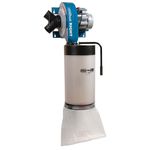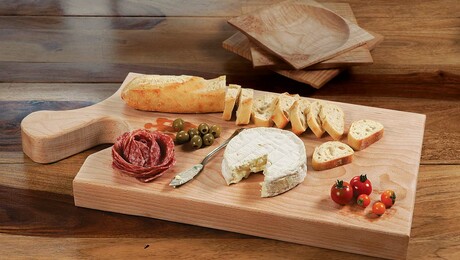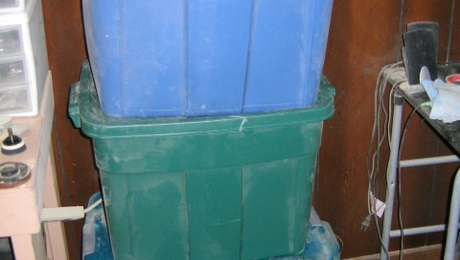The Best Food-Safe Finish May Be None at All
Synopsis: Seri Robinson, a professor of wood anatomy, agrees with the marketers of “food-safe” finishes that bacteria-especially salmonella, listeria, and E. coli-are a threat to human health. But, Robinson says, those finishes can undermine the natural antimicrobial properties of wood. If an unfinished wooden cutting board or spoon is rinsed after use and allowed to dry on all sides, the drying action will pull bacteria deep into the wood, where it will be trapped and die. A finish will keep bacteria close to the surface, where it will multiply.
The market is saturated with finishes that purport to be “food-safe.” Part of what manufacturers mean is that these finishes are safe when ingested in small amounts, especially when they are fully cured. And they are right.
However, where many of the manufacturers and marketers go wrong is in promising that these finishes will head off an even bigger danger. The idea is that they will prevent harmful bacteria from getting into the wood’s pores—where popular wisdom says it will keep on infecting your food forever.
As a professor of wood anatomy, I’ve done quite a bit of research into food-safe finishes. The results might surprise you. One thing everyone seems to have missed is that wood doesn’t have a bacteria problem. Unfinished wood is naturally antimicrobial. In fact, when rinsed and dried properly between uses, it is self-cleaning. Wood finishes only serve to undermine this amazing property of wood.
Of course, there are other reasons woodworkers finish their projects, aside from warding off bacteria. First, finishes improve the look of most species, deepening color and depth and making figure stand out. Second, by slowing the movement of water vapor in and out of the wood, finishes can help prevent cracking and warping. Finally, finishes guard against stains.
However, for food-related items specifically (as well as children’s toys), these reasons fall apart. Raw spoons and cutting boards won’t crack or warp if cared for properly, and they won’t hold stains very long either, due to the self-cleaning process outlined below. Most importantly for human health, they won’t transmit harmful bacteria back to the user.
I’ll dive more deeply into each of these issues, but the bottom line is this: The best finish for items that will come into contact with food and/or mouths is no finish at all.
If after flipping through this article, however, you still feel driven to apply oil or wax to your next cutting board, check out the section titled “If you must finish.”
Bacteria is the real danger
Marketers of “food-safe” finishes are right about the dangers presented by bacteria, whether it comes from meats and vegetables or the human mouth. The three most dangerous in food are salmonella, listeria, and E. coli.
Salmonella is an anaerobic (doesn’t need oxygen) bacteria genus that can cause fever (including typhoid), diarrhea, vomiting, stomach pains, and even death in extreme cases. E. coli can cause cramps, bloody diarrhea, and vomiting.
|
|
|
Listeria is a much more serious bacteria, which can cause miscarriage, among many other problems. Listeriosis can also be fatal for folks over 65 years of age. Worse yet, listeria can survive refrigeration and freezing, making it much more pervasive than E. coli and salmonella.
Cross-contamination is a myth—Both vegetables and meat have bacteria on them, particularly E. coli, so let’s kill the cross-contamination myth right away. Cutting vegetables on a separate board, for example, accomplishes nothing, as harmful bacteria from veggies is just as likely to transfer to meat—or fruit, for that matter.
That said, if the meat is to be cooked and the veggies aren’t, it’s probably better to cut veggies first when you are cutting both on one surface in the same session.
Raw wood has an inherent ability to self-clean
To understand why finish is the enemy on food-related woodwork, let’s take a quick look at wood’s anatomy and physics.
Popular wisdom says that microbes multiply in raw wood, growing and waiting until—Whammo!—the listeria army attacks your charcuterie party.
That’s not how raw wood and bacteria interact, and there are decades of research to back this up, as well as centuries of safe contact between food and unfinished wood. Here’s what is actually happening.
Wood is constantly gaining and losing moisture from the air around it. In scientific circles we refer to this as wood’s hydroscopic property. Wood does the same when it comes in contact with any liquid, such as water from a sink or juice from an uncooked steak.
Wood also wants to bring its own moisture content into equilibrium, throughout the board. So when the surface of a relatively dry cutting board or spoon becomes wet, the wood draws that moisture toward the interior, taking bacteria with it.
So if bacteria is drawn into the wood with moisture, why won’t it come back out and wreak havoc? If you give your cutting board or spoon a rinse after use and let it dry on all sides, the drying action will continue to pull bacteria deep into the wood, where it will be trapped and die. Little to none will be left on the surface, at least not enough to transfer. This is what I mean when I say wood is antimicrobial. See “Self-cleaning nature of wood” below to better understand this process.
Study after study has shown this to be true across many wood species, wood thicknesses, and bacteria types. So enjoy this unusual moment when the science is all in agreement!
Raw wood will manage stains too—Go ahead and cut strawberries and blueberries on your unfinished board. Yes, there will be some immediate color left in the wood. But just like the bacteria, it will be drawn progressively inward with each wet-dry cycle. So after every wash, there will be a little less of the stain on the surface. And after seven or eight days of use, the stain will be gone from view.
Don’t polish the surface too much—Because you are not finishing the wood, you might be tempted to sand it to a high polish, which will highlight the beauty somewhat. But I’ve found that sanding beyond 400 grit tends to slow the absorption of liquid and moisture, hampering that self-cleaning ability.
The process in real life. These photos were taken over eight days after a board was stained with blueberry juice. They show how repeated rinse/dry cycles remove stains and contaminants from the surface of raw wood.
Self-Cleaning Nature of WoodRaw wood has an inherent ability to absorb, contain, and kill bacteria. Here’s how it works. 1. Board is exposed to food substances. 2. Board is rinsed off 3. Board absorbs water and bacteria 4. Water evaporates, leaving bacteria behind |
Proper care is critical
While you should wash your cutting board between uses, don’t allow the water to soak in too deeply. You just need to get the surface wet and wipe off any excess food particulates. So don’t put wood items in the dishwasher or soak them in the sink.
You can use soap if you want, but studies have shown it doesn’t make a difference. The same goes for hot water. Just put your board or spoon or toy under a faucet of cold water and wipe it down.

After that, the surface needs time to dry so bacteria is drawn inward from every direction. This might take 24 to 48 hours of airflow on all sides. The best way to do this is on something like a wire rack, which minimizes surface contact. If you remember, flip the wood over at the 24-hour point. Propping up the item to dry can work too, but any part in contact with the countertop can collect water and might even discolor and mold.

Do not put wood items away while they are still wet. The darkness and lack of airflow will encourage mold growth.
You could also consider putting little feet on your cutting board so it can dry directly on the counter. The downside here is that only one side of the board will be usable. You might get a touch of mold around the feet, but that’s not really a concern.
Why any finish is problematic
Any finish, whether it builds a film or not, will clog the wood’s vessels, rays, and fibers and impair its ability to cycle water. This is a benefit for most projects, helping wood resist stains, warping, and seasonal movement. But it’s a problem for food-related items and toys, as it will keep the bacteria on the surface, where it will multiply, instead of allowing it to migrate inward and die. Even one coat of an oil finish will suppress water movement and cause bacteria to breed.
“Conditioning” is a myth—Another myth is the need to “condition” a cutting board by periodically reapplying an oil finish. Almost all commercial cutting-board makers have a “wood conditioner” they recommend, usually a blend of waxes and oils, meant to both seal the wood and make it shine. They’ve convinced the public that wood should be kept moist and shiny, not dry and matte.
Wet wood molds. Dry wood is safe wood. And finishes impair the wood’s ability to clean itself. Don’t fall victim to marketing. Your cutting board doesn’t need to be conditioned. It needs to be a flat, clean surface for cutting things. To add flair, try using figured or spalted wood.
For food-related items, get used to how wood really looks. You’ll save money and have a healthier family in the process.
Never finish cooking spoons—It’s especially important not to finish cooking spoons, regardless of how much you want the color or grain to pop. Wood spoons are subjected to the toughest aspects of the kitchen, including prolonged exposure to boiling water and highly acidic substances like hot pasta sauce.
Boiling water will get underneath a finish and cause mold to grow. In addition, with the finish impeding the movement of moisture, tomato sauce will stain your spoon permanently.
Bread boards are an exception—Not all cutting boards will be exposed to moisture and therefore bacteria. If you have a board dedicated to bread, feel free to apply a finish to it. The same goes for a charcuterie board that will only contact hard meats and hard cheeses.
Choose one of the finishes recommended below (“If you must finish”), give the cutting board an occasional rinse (letting it dry fully afterward), and you’ll be fine.
Glued-up projects aren’t great either
Complex patterns are very popular for cutting boards, giving folks a chance to empty their scrap bins and demonstrate their skills. Like wood finish, however, glue also fills wood cells, impairing their ability to move moisture. In a piece of furniture, that doesn’t matter. But in a cutting board, those gluelines make it harder for the wood to self-clean. They can also become places for bacteria, mold, and stains to build up. Conflicting grain orientations can also lead to cracking and warping after repeated wet/dry cycles.
In the end, the best cutting board is an unfinished slab. If you want to combine woods to add style, use as few gluelines as possible.
|
If you must finish
To highlight the wood’s grain and figure, at least initially, you may still decide to finish. The best options won’t last long, but they will help your holiday gift make a good first impression.
The best finish for food-related items is a soft furniture wax, which will give the wood some initial depth and shine but wear off after a few wash-dry cycles. Stay away from waxes that are emulsified in an oil carrier, such as those sold for wood turning.
If you want the look of an oil finish, go with just one coat, and avoid raw or unrefined natural oils such as olive oil, grape-seed oil, and raw linseed oil. These can take months to cure if they cure at all, and they can become rancid.
You should also steer clear of finishes like polyurethane and shellac that form a film. These will chip and crack with use. Not only will that look bad and be difficult to repair, but differences in water movement between areas with intact and broken finish could lead to cracking, warping, and mold growth.
The worst option for food- or kid-related items is any finish that is formulated for outdoor use, as it is likely to contain dangerous chemicals.
-Seri Robinson, a professor of wood anatomy at Oregon State University, is the author of numerous books on turning, spalting, and wood technology.
Fine Woodworking Recommended Products

Rockler Dust Right 1250 CFM
You’ll need help to get this heavy unit onto its bracket, but if you’re looking for a central dust collector that won’t gobble floor space, this may be the unit for you.

Foam Brushes
Foam brushes are great for applying a variety of stains and finishes, and the 2″ wide brush is the most versatile. Comes in a pack of 48.

Waterlox Original
Versatile wiping varnish is easy to apply and great for both satin and gloss finishes.
Sign up for eletters today and get the latest techniques and how-to from Fine Woodworking, plus special offers.
Download FREE PDF
when you enter your email address below.

















